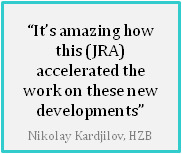Neutrons help visualising materials: new video of the Imaging JRA
07/04/2014
Neutron imaging makes it possible to visualise the structure of a range of materials and to obtain information on material and magnetic systems, which are inaccessible to other techniques. New imaging methods will offer new possibilities to physicists, material scientists, engineers, palaeontologists, archaeologists, and others, so that they can obtain better information on their objects of study. Nikolay Kardjilov from the Helmholtz-Zentrum Berlin (HZB) is the coordinator of the NMI3 Imaging Joint Research Activity (JRA). In the video, he tells about the aims of the groups involved in this collaboration.
Advancements in the neutron imaging field
The Imaging JRA is working on new methods and tools that will allow to look at very small structures into detail, and to use neutron scattering to complement existing imaging techniques.

This collaboration has started two years ago and the work is proceeding very well. For instance, HZB in Germany has provided his users with a prototype high resolution detector system for neutron tomography, and a new double-crystal monochromator setup. Teams at the Paul Scherrer Institute (PSI) in Switzerland have built a prototype for high resolution neutron tomography, and achieved a very powerful lens system. Colleagues at the Heinz Maier-Leibnitz Zentrum (MLZ) in Germany, have used polarized neutrons for imaging and for small angle neutron scattering in order to analyse magnetic systems. Thanks to this JRA, different methods could be combined together in other facilities, so everyone could beneficiate from this work. PSI, MLZ, HZB, the Budapest Neutron Centre and the Leon Brillouin Laboratory (LLB) are working together on a combination of techniques, such as magnetic imaging using polarized neutrons; innovative sample environment; a high resolution detector system, new gratings for a Talbot-Lau interferometry setup. These and other achievements are important contributions to the field of neutron imaging.
The advantages of an NMI3 JRA
Nikolay has stressed several advantages of being part of a collaboration supported by NMI3. Even though cooperation between different institutes existed in the past, having an established NMI3 JRA has accelerated the pace in which their work moves forward. According to Nikolay, “what previously took years to achieve, now takes months”, Given that goals and tasks are predefined, the management and organization run smoothly, and scientists can count on fundamental financial support to meet, exchange ideas, and also to hire new experts to perform the work. Thanks to this collaboration it is easier to network with communities external to neutron scattering, who would otherwise seldom meet.
JRA partners
Useful links
Contact: Inês Crespo
Related articles
16.09.2013 – JRA series: Imaging at BNC
Watch Zoltán Kis and László Szentmiklósi from the BNC describe their work as part of the Imaging JRA.
16.09.2013 - Neutron Imaging at BNC
Watch László Szentmiklósi & Tamás Belgya from the BNC explain work carried-out on the Prompt-gamma Activation Analysis and Neutron Induced Prompt-gamma Spectrometry (PGAA-NIPS) facility.




